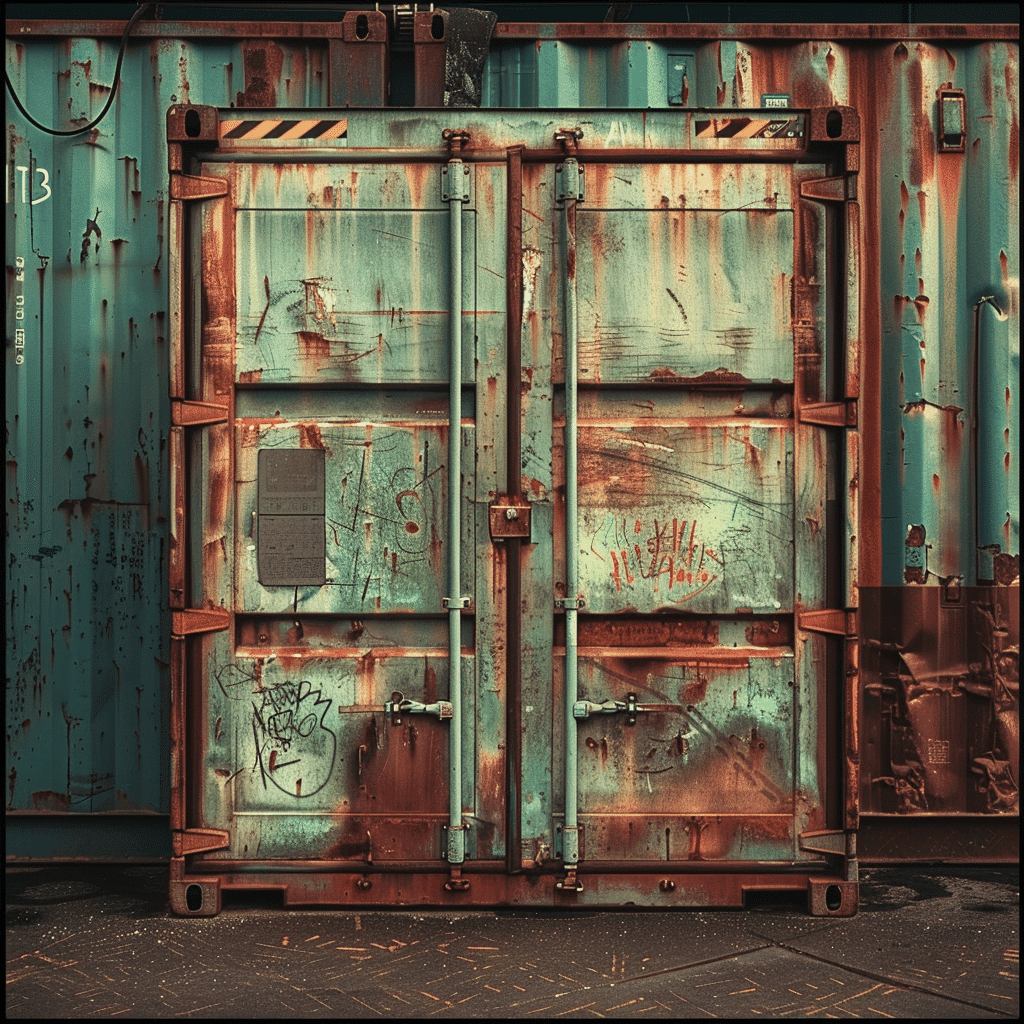Do you ever wonder how long shipping containers last? Well, you’re in luck! In this article, we’ll explore the lifespan of these versatile containers and why it’s important to know.
Whether you’re a business owner or looking to repurpose a container for residential use, understanding their durability is key. So, let’s dive in and discover the factors that affect their longevity, from weather impacts to proper ventilation.
Get ready to learn all about shipping containers and how long they can last!
When considering the long lifespan of of shipping containers, it’s important to understand their durability and potential for repurposing.
Shipping containers, also known as storage containers, are designed to withstand harsh weather conditions and rough handling during transportation. They’re made from high-quality steel, which contributes to their longevity and ability to protect the goods inside.
The average shipping container lifespan can vary depending on factors such as maintenance, usage, and exposure to corrosive elements like saltwater. However, with proper care and maintenance, a shipping container can last up to 20 years or more.
This durability makes them an ideal choice for various applications beyond shipping, including transport goods storage, housing, and even artistic projects.
The Importance of a Container’s Lifespan
Understanding the lifespan of shipping containers is crucial for businesses and homeowners alike. Whether you’re using shipping containers for storage, transportation, or even as a living space, it’s important to know how long they’ll last before needing to be replaced. On average, shipping containers can last anywhere from 10 to 25 years, depending on various factors such as the quality of the container, the environment it’s exposed to, and how well it’s maintained.
For businesses, knowing the shipping container lifespan, is essential for planning and budgeting purposes. Container leasing companies often provide containers with a guaranteed lifespan, allowing businesses to make informed decisions about their investments. Additionally, proper maintenance can significantly extend the life of a shipping container, saving businesses money in the long run.
Similarly, homeowners who are considering using shipping containers for residential purposes need to understand their lifespan. Proper maintenance and regular inspections can help ensure the longevity of the shipping container homes and provide a safe and comfortable living environment.
Determining How Long Shipping Containers Last
To determine the lifespan of shipping containers, you need to consider various factors such as container quality, environmental conditions, and maintenance.
Shipping containers are designed to be extremely durable and withstand the harsh conditions of transportation and storage. On average, containers tend to last around 20 years. However, this lifespan can vary depending on several factors.
The quality of the container plays a significant role in determining its longevity. High-quality containers made from corten steel are more resistant to corrosion and can last longer.
Environmental conditions also have an impact on the lifespan of shipping containers. Containers located in coastal areas, where they’re exposed to saltwater and high humidity, may have a shorter lifespan due to accelerated corrosion.
Regular maintenance, including inspections, cleaning, and repairs, can help extend the lifespan of shipping containers.

Weather Impact
Considering the impact of weather on shipping containers, you should be aware of how different environmental conditions can affect their lifespan.
One important factor to consider is the type of steel used in the construction of the container. Many steel shipping containers are made with weathering steel, which is designed to withstand harsh weather conditions.
However, moisture can still be a problem for these containers. If a container is placed on damp ground or in wet climates, it can be exposed to prolonged periods of moisture, leading to corrosion and reducing its lifespan.
It’s crucial to take preventive measures, such as a proper foundation, insulation and regular maintenance, to protect the containers from the damaging effects of weather and ensure their longevity.
Physical Damage
One important aspect to consider is how physical damage can impact the lifespan of shipping containers. These containers are made of steel, which is known for its incredible durability. However, when subjected to physical damage, such as dents, scratches, or punctures, the structural integrity of the container can be compromised.
This can lead to a decrease in its lifespan and potential issues during transportation and storage. Even though shipping containers are designed to withstand harsh conditions, they aren’t invincible. It’s crucial to handle them with care to prevent any damage that could shorten their lifespan.
Regular inspections and maintenance can help identify and address any physical damage early on, ensuring that the containers remain in good condition for as long as possible.
Usage and Lifespan
You can maximize the usage and lifespan of shipping containers by implementing proper maintenance and care. The average lifespan of a shipping container is around 20 years, but with the right practices, you can extend its usability.
Regularly inspect the container doors to ensure they’re functioning properly and replace any damaged seals or hinges.
To prevent moisture and reduce internal condensation, use moisture-absorbing materials like desiccants or silica gel packets.
It’s also crucial to keep the containers in good condition by regularly cleaning them, repairing any dents or scratches, and repainting them to prevent rusting.
Avoid placing items directly against the container walls to minimize moisture contact.
Considering The Age: Used vs. New
To determine the lifespan of shipping containers, it’s important to consider whether they’re used or new.
Used containers have already endured wear and tear from previous journeys, and their lifespan may be shorter compared to newer containers.
The lifespan of a shipping container can vary greatly depending on its maintenance and the conditions it’s exposed to. However, on average, a used container can last around 10 to 12 years, while newer containers can last up to 25 years or more.
It’s worth noting that the lifespan of a shipping container can be extended through regular maintenance and repairs.
The Significance of Inspecting Used Containers
Regularly inspecting used shipping containers is essential in ensuring their longevity and functionality. When purchasing a used container, it’s crucial to thoroughly inspect it for any signs of damage or wear. By conducting a comprehensive inspection, you can identify any potential issues or weaknesses that may affect its performance and durability.
This not only helps in determining the overall condition of the container but also allows you to make informed decisions regarding repairs or maintenance. Inspecting the exterior for dents, rust, or corrosion is vital, as these factors can significantly impact the whole container’s condition and structural integrity. Additionally, inspecting the interior for signs of water leakage or pest infestation is crucial to prevent any damage to the cargo.
Regular inspections of used shipping containers ensure that they’re in optimal condition, allowing them to last longer and function effectively for your shipping needs.
The Importance of Dry Storage Locations
To ensure the longevity of your shipping container, it’s crucial to store it in a dry location. Dry storage locations are essential because they help prevent excess moisture from seeping into the storage container, which can cause corrosion and lead to rust spots.
When a shipping container is exposed to moisture for extended periods, it becomes susceptible to damage and deterioration. By keeping your container in a dry storage location, you can significantly extend its lifespan and protect it from the damaging effects of moisture.
The Protective Role of Paint Against the Elements
Paint plays a crucial role in protecting shipping containers from the elements. It forms a barrier against moisture and prevents rust formation. The steel supports of shipping containers are vulnerable to corrosion when exposed to harsh conditions, such as rain, snow, and saltwater. The application of paint acts as a protective shield to protect goods within, preventing direct contact between the steel and the elements.
The paint acts as a barrier, sealing the surface and preventing moisture from seeping into the container’s construction materials. This is especially important since shipping containers are often exposed to extreme weather conditions during transportation and storage. Without proper paint protection, the steel supports would quickly deteriorate, leading to structural weakness and potential damage to the contents of the container.
Therefore, regular maintenance and repainting are essential to ensure the longevity and durability of shipping containers.

Internal Care
Inspect your shipping storage container’s interior regularly to ensure proper maintenance and prevent any potential issues. Shipping containers are built to withstand rough conditions and heavy use, but even with their durable construction, they require attention to maintain their longevity.
As a private owner, it’s your responsibility to keep an eye on the container’s interior. Over the course of decades, the floor of the container can experience wear and tear. Look for any signs of corrosion or damage, such as rust or holes. If you notice any issues, address them promptly to prevent further deterioration.
Regularly cleaning the interior is also essential to prevent the buildup of moisture, which can lead to mold or mildew. By taking these steps, you can ensure that your shipping container remains in good condition for many years to come.
Ensuring Ventilation To Prevent Internal Moisture
To prevent internal moisture, ensure proper ventilation within your shipping container.
Proper ventilation is essential in preventing the buildup of condensation, which can lead to mold, mildew, and corrosion. Shipping containers are designed with small vents, but these may not be sufficient for adequate airflow.
To ensure proper ventilation, consider installing additional vents or exhaust fans to promote air circulation. Regularly inspect and clean the vents to remove any debris or blockages.
It’s also important to maintain a balance between ventilation and insulation to prevent excessive heat loss or gain.
The Role of Rubber-Sealed Doors in Preventing Water Ingress
Ensure that your shipping container has rubber-sealed doors to effectively prevent water ingress. The role of rubber-sealed doors in preventing water ingress is crucial for the longevity of shipping containers. These doors create a watertight seal, preventing any water from entering the container and causing damage to the container doors or contents.
By keeping the interior dry, the rubber seals help to prevent rust, corrosion, and mold growth. Whether you’re transporting goods or using the container for storage, water ingress can lead to significant damage and loss.
Therefore, it’s essential to invest in high-quality rubber-sealed doors that are designed to withstand harsh weather conditions and maintain their effectiveness over time. Regular maintenance and inspection of these seals are also important to ensure their continued functionality in preventing water ingress.
Frequently Asked Questions
Are shipping containers good for long term storage?
Shipping containers are designed to be durable and weather-resistant, making them suitable for long-term storage. Their sturdy construction protects contents from external elements, and with proper maintenance, they can serve as a reliable storage solution for many years.
Do shipping containers rust?
Shipping containers are made of steel and can begin to rust over time if not properly maintained. The rust forms due to an oxidation reaction between the steel, oxygen, and water, resulting in a layer of rust.
How often do shipping containers go missing?
While a vast number of containers are transported across the world’s oceans, only a small fraction goes missing. An estimate once suggested that as many as 10,000 containers might be lost at sea annually. However, a more recent study by the World Shipping Council between 2008 and 2016 found that an average of 568 containers were lost per year, excluding catastrophic events. When accounting for such events, the number rises to approximately 1,582 containers lost annually.
Conclusion
To wrap up, it’s essential for you to thoroughly assess the condition of the seals when purchasing a shipping container in order to ensure its longevity and durability. By doing so, you can extend the lifespan of the container and minimize the risk of any damage caused by water or pests.
However, it’s important to note that even with proper seal maintenance, shipping containers have a certain amount of wear and tear due to factors like weather conditions and handling during transportation. Nonetheless, by regularly inspecting and maintaining the seals, you can minimize the risk of any potential damage.


